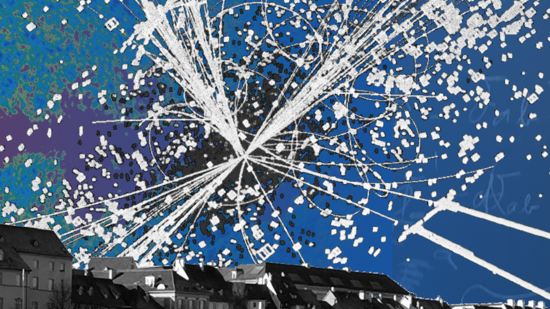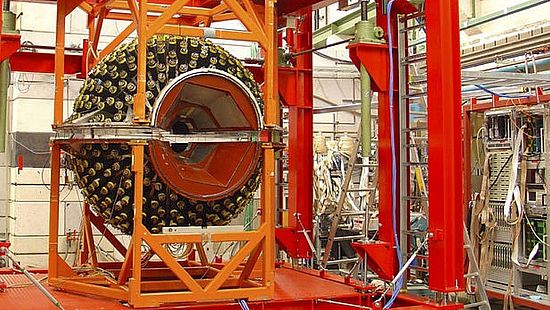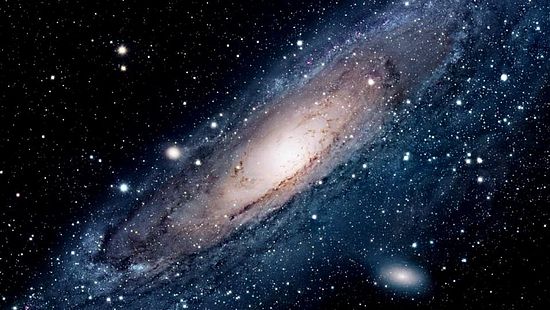The Deep Underground Neutrino Experiment

The Deep Underground Neutrino Experiment (DUNE) is a proposed neutrino oscillation experiment which will observe neutrinos from an intense neutrino beam created at Fermilab in Illinois and aimed at a liquid argon detector at the Sanford Underground Research Facility in South Dakota, which are roughly 1300 km apart. Neutrinos are the most abundant matter particles in the universe, but are affected only by the weakest of nature's forces (but for gravity) and are therefore essentially unabsorbed as they travel through the universe. The Dune experiment will explore their properties and will furthermore search for the decay of protons, which would be a signature of an underlying unified theory of nature's forces. The theory group of Prof. Stefan Antusch joined the DUNE collaboration in 2016.
The Future Circular Collider Study

he Future Circular Collider Study (FCC), launched 2014 and hosted by CERN, explores different technical designs of circular colliders for the post-LHC era, and the possible physics questions that could be answered by such an experiment. Since the FCC would reach higher energies than the LHC and unprecedented luminosities, it would allow to explore the fundamental laws of nature beyond the possibilities of present experiments. The theory group of Prof. Stefan Antusch is member of the FCC collaboration and contributes to the working groups where the discovery potential for new physics phenomena is investigated.
The CBELSA/TAPS experiment at ELSA

This experiment is installed at the Bonn ELSA accelerator which can deliver electron beams of up to 3.5 GeV. These beams are used to produce tagged bremsstrahlung photons. The photon beams can be polarized (circularly when the electron beam is longidutinally polarized of linearly when coherent bremsstrahlung is produced in a diamond foil). Longitudinally and transversely polarized targets are also available, so that double polarization observables can be investigated. The photon beams impinge on the production target where they can excite the target nucleons which subsequently decay back to the nucleon ground state via the emission of different types of mesons (for example pions, eta-, eta'-, omega-mesons, and kaons as well as multiple meson final states like pion and eta-pion pairs. The reaction products are detected with a combined electromagnetic calorimetrer consisting of the Crystal Barrel detector (CsI scintillators) covering most of the solid angle around the target and a subunit of the TAPS detector (BaF_2 scintillators) covering forward angles. In addition, detectors for charged particle identification are used in the setup. The aim of this experiment is a much better understanding of the excitation spectrum of the nucleon via the investigation of many different observables for a multitude of final states. The group of Prof. Krusche is member of this collaboration since 1999. Prof. Krusche is one of two spokespersons of this collaboration.
The Crystal Ball/TAPS experiment at MAMI

This experiment is similar to the setup at the CBELSA/TAPS experiment. The Mainz MAMI accelerator, which is a cascaded racetrack microtron, can deliver electron beams with energies up to ~1.5 GeV. It is routinely operated with longitudinally polarized electrons. The beam intensities can be much higher than at the Bonn facility. Actually, for tagged photon beams the accelerator does not limit beam intensity (it can be operated with beams more intense by several orders of magnitude which are used for electron scattering experiments. The beam intensity is only limited by the count rate capabilities of the tagging spectrometer and the production detector. Also here, circularly polarized photon beams (from longitudinally polarized electrons) and linearly polarized coherent bremsstrahlung can be used and longitudinally and transversely polarized targets are available. Due to the high count rate capabilities and the excellent beam quality, this setup is mainly used for precision experiments at moderate photon energies. The group of Prof. Krusche is member of this collaboration since 1999.
The BGO-OD experiment at ELSA

The second experiment at the ELSA accelerator is still in the final test phase and just starts to deliver data. It uses also a tagged photon beam, but at present no polarized targets. The main components of the detector are the BGO calorimeter, previously used in the GRAAL experiment, and a dipole magnet (and tracking detectors) at forward angles. It will thus combine an almost 4pi coverage for photons with magnetic spectrometry for forward-going charged particles. These features allow an efficient detection of neutral mesons, using invariant-mass analysis for their photon decays, together with high-resolutionmomentum spectrometry for recoil protons. The group of Prof. Krusche is member of this collaboration since 2010.
The MUSE experiment at PSI

The MUSE experiment at PSI in Villingen, Switzerland will provide key information for the proton radius puzzle. The idea is to measure simultaneously the scattering of electrons and myons from a mixed beam off protons. The direct comparison of the proton radius obtained from the two reaction types will eliminate many sources of systematic uncertainty and should clearly prove whether there is or is not a difference between electron - proton and myon - proton interaction, which goes to the very basis of the standard model. The experiment is expected to test lepton universality in a scattering experiment with a precision better by one order of magnitude compared to any previous results. The measurement will be done with both beam polarities so that comparison of electron-positron and of negative - positive myon scattering will also allow to study the influence of two-photon exchange contributions. The experiment is still in the setup phase, but beam times to test several components have already been done. The group of Prof. Krusche joined this collaboration in 2016.
The PANDA experiment at FAIR, Darmstadt Germany

During the next few years a huge new accelerator complex will be build in the framework of the FAIR project at the site of the GSI facility close to Darmstadt, Germany. The project rests on four pillars, an antiproton beam with a multipurpose detector called PANDA, a new experiment for compressed nuclear matter (heavy ion physics), facilities for nuclear structure studies for nuclei far of stability, and plasma physics. During the last 15 years our group has been involved in the R & D work for the PANDA detector, for which we have developed crucial components for the forward wall of the electromagnetic calorimeter. Construction of this sub-detector will be finished in 2018, however production data for the full setup are not expected before 2025. The group of Prof. Krusche is member of this collaboration since 2003.
Quick Links



